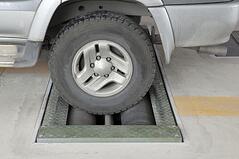The numbers and letters printed on the sidewall of your car’s tires represent all of the information you could ever need about the tires. When it is time to replace, repair, or service your tires, you may need parts or all of the information contained in the series of numbers. Most drivers are unsure how to interpret the data on their own, but once you know what each tire number represents that task becomes much simpler. 
Service or Class
The sidewall numbers on most tires start with a letter that indicates the service or class of tire. For example, the letter “P” signifies the tire is meant for a passenger vehicle. Other service or class letter distinctions are “T” for temporary spare tires, “LT” for light truck tires and “ST” for special trailers. Tires that do not begin the number series with a letter are “Eurometric” tires that are measured based on European specifications.
Tire Width
After the class letter, the first number on the sidewall will be the tire width measurement. The section width is taken in millimeters from the edge of one sidewall to the other over the tread of the tire. Tires with larger section width numbers will almost always be wider than tires with a smaller section width number.
Aspect Ratio
The aspect ratio of a tire is a mathematical comparison between its sidewall width and height. The number listed on a tire’s sidewall after its section width represents that ratio percentage. For example, if the aspect ratio number is 60, that means the height of the tire’s sidewall is 60% of its width. If you ever need to know the height of your tire’s sidewall, simply use the aspect ratio percentage and section width number to arrive at the correct height measurement.
Wheel Construction
In all likelihood, the letter following the aspect ratio on your tire will be the letter “R.” This letter indicates the internal construction of the tire, which has been generally standardized to radial, or “R,” construction for the last two decades.
Rim Diameter
The correct wheel diameter for a tire, measured in inches, is listed on the tire’s sidewall after its construction classification. The wheel, or rim, diameter measurement becomes important if you decide to purchase a different size of wheel for your car. Check the wheel diameter number on your existing tire’s sidewall to determine if you also need to upgrade the size of the tires.
Load and Speed Index
After the wheel diameter, the tire’s load and speed index numbers will be listed on the sidewall. Higher numbers are rated safe to carry heavier loads, while lower numbers represent tires classed for lighter loaded. The load index number can be looked up online using a standardized load-carrying capacity chart. The letter directly after the load capacity is the speed index, which indicates the safe range of speeds the tires can travel while carrying its maximum load capacity. Use this set of numbers and a letter to make sure the next set of tires you buy have comparable load and speed indexes.
The series of numbers listed on the sidewall of a tire tell you the size, construction, safe driving speeds, and load capacity of that particular tire. Use this information when you repair deflated tires or replace bad tires on your car.
*Image courtesy of freedigitalphotos.net




